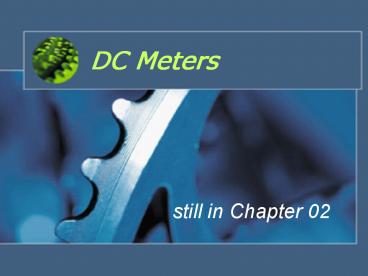DC Meters PowerPoint PPT Presentation
1 / 24
Title: DC Meters
1
DC Meters
- still in Chapter 02
2
Warm-ups
- stand-up 3x.
- sit down and relax.
- listening to a song by Halim Yazid titled
ingat sokmo hok mok pesan. - take a deep breath.
3
Objectives
- At the end of this chapter, the students should
be able to - explain the meaning of electrical meters.
- explain the purpose of shunts across a meter.
- calculate the value of shunt resistors across a
meter.
4
Outlines
- Introduction What is a meter?.
- Pmmc in a DC Ammeter.
- Ammeter Insertion Effects.
5
Introduction
- What are meters?
- Meters are used to measure current and voltage.
- The meter most likely encountered will be a
single low range meter such as 0 - 1 mA full
deflection meter of the D'Arsonval type. - The d'Arsonval type meter works on the principle
a coil of wire to which a pointer is attached is
pivoted between the poles of a permanent magnet.
6
Introduction
- What are meters?
- When current flows through the coil, it sets up a
magnetic field that interacts with the field of
the magnet to cause the coil to turn. - The meter pointer deflects in direct proportion
to the current. This meter is called an ammeter.
7
Introduction
Figure 1 A typical 0 to 1mA ammeter.
8
DC Ammeter
- DC Ammeter
- a device used to measure current.
- put in series/ parallel with the circuit.
- very common in lab.
- use unit Ampere (A)/ mA.
- used the principle of the dArsonval meter
movement with slight modification.
9
DC Ammeter
- DC Ammeter
- placing a LOW resistance in PARALLEL with the
meter movement resistance to increase the range
of current that can be measured by the meter. - Rsh shunt resistor.
- Rm meter movement resistance.
10
DC Ammeter
- Ish current tru the shunt.
- Im full-scale deflection current of meter
movement. - I full-scale deflection current for the
ammeter.
Figure 2 dArsonval used in DC Ammeter circuit.
11
DC Ammeter
- Vm ImRm
- Vsh Vm
- Ish I Im
- Rsh Vsh /Ish
- ImRm /Ish
- Im/(I -Im)Rm ?
Figure 2 dArsonval used in DC Ammeter circuit.
(single range only).
12
DC Ammeter
- Example 2-1
- Calculate the value of the shunt resistance
required to convert a 1-mA meter movement, with a
100-? internal resistance, into a 0- to 10-mA
ammeter.
13
DC Ammeter
- Example 2-2
- A 100-mA meter movement with an internal
resistance of 800-? is used in 0- to 100-mA
ammeter. Find the value of the required shunt
resistance.
14
Ayrton Shunt
- Also known as the universal shunt.
- Used on a multiple range ammeter.
- It eliminates the possibility of the meter
movements being in the circuit without any shunt
resistance. - It maybe used with a wide range of meter
movements.
15
Ayrton Shunt
Fig. 3 An Ammeter using Ayrton shunt.
16
Ayrton Shunt
From figure (RbRc)(I2-Im) Im
(RaRm) I2(RbRc) - Im(RbRc) Im Rsh-(RbRc)
Rm) I2(RbRc) - Im(RbRc) ImRsh- Im(RbRc)
ImRm. ThusRbRc Im(RshRm) / I2 (1) Ra Rsh
(RbRc) (2) Rc Im(RshRm) / I3 (3)
Fig. 3 An Ammeter using Ayrton shunt.
17
Ayrton Shunt
- Remember
- n I / Im
- Rsh Rm / (n-1) n 20.
18
Ayrton Shunt
Example 2.3Compute the value of the shunt
resistors for the circuit. Given that Rm 1k?,
Im 100 mA, I110mA, I2100mA, I31A. Check
Rsh Ra Rb Rc always!
Fig. 3 An Ammeter using Ayrton shunt.
19
Ammeter Insertion Effects
- A frequently overlooked source of error in
measurements. - All ammeters contain some internal resistance.
- inserting an Ammeter in a circuit always
increases the resistances of the circuit,
therefore reduces the measured current in the
circuit. - The error caused by the meter depends on the
value of resistances in Ammeter and also the
measured circuit.
20
Ammeter Insertion Effects
Fig.4a Expected current in a simple circuit. I
E / R1
Fig.4b Expected current in a series circuit
with an ammeter. I E / (R1Rm)
21
Ammeter Insertion Effects
- Example 2.4
- A current meter having an internal resistance of
88? is used to measure the current trough Rc in
figure below. Determine the percentage of error
due to the ammeter insertion. - Given that
- RaRbRc 1k?
22
Summary
- In this chapter, we have discussed about
- introduction to electrical meters.
- shunt resistor in a single-range Ammeter.
- universal shunt in multiple-range Ammeter.
- calculation of shunt resistors.
- ammeter insertion effects.
23
Conclusion
- Also known as the universal shunt.
- Used on a multiple range ammeter.
- It eliminates the possibility of the meter
movements being in the circuit without any shunt
resistance. - It maybe used with a wide range of meter
movements.
24
Evaluation
- Quiz.

